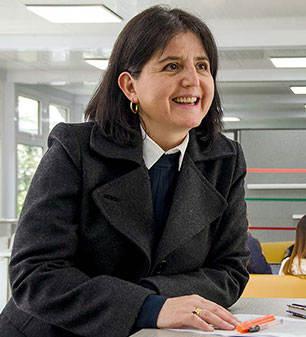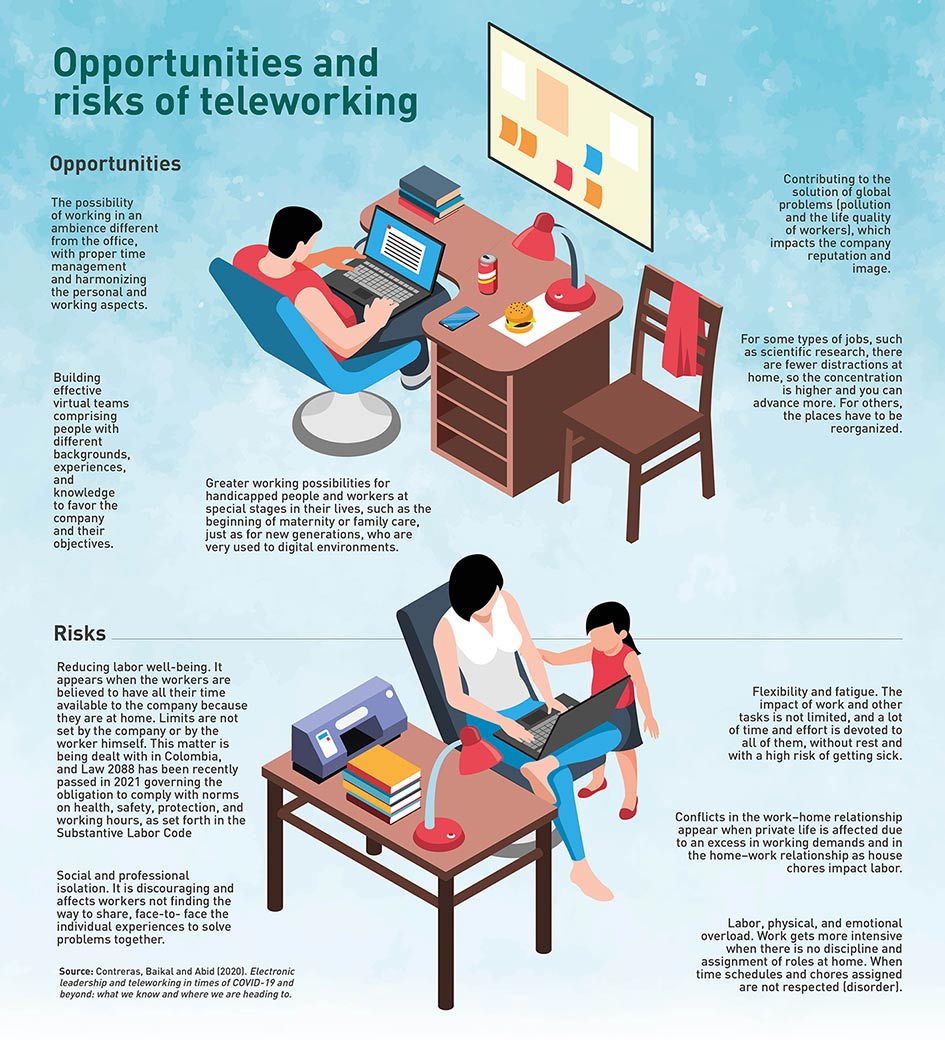Teleworking: arrived earlier than expected and laden with challenges for organizations
By: Marisol Ortega Guerrero
Photos:
Science and Tech

By: Marisol Ortega Guerrero
Photos:
In 2018, there were 122,278 teleworkers in Colombia. According to data from the Corporación Colombia Digital, the Consulting National Center, and the Ministry of Information Technologies and Communications, that number increased 400% in March 2021, one year after the COVID-19 pandemic was declared.
This figure shows an exponential and dizzying increase in the way people work. Although many companies perceived this transformation as something upcoming in the not too distant future, very few nations around the world were truly prepared for its prompt occurrence.
However, teleworking has been legalized in Colombia by Law 1221 passed in 2008 and ruled by Decree 884 (2012), which defines this activity as “a form of labor organization, which comprises performing paid activities or rendering paid services to third parties using information and communication technologies (ICT) as a support, to put the worker and company in contact, without the need for the worker’s physical presence at a specific working site.”
The new reality the COVID-19 pandemic brought about, which for most people has become a real headache, poses a challenge for companies that need to consolidate their management to include effective “e-leaders” and the total mediation of information technologies, enabling them to become more competitive and efficient.
Professor and researcher Francoise Contreras, from the School of Business Administration and the Business and Management Research Group at Universidad del Rosario (Colombia),and expert in Leadership and Organizational; Ghulam Abid, from Kinnaird College for Women University, in Lahore (Pakistán), and Elif Baykal, from Universidad Medipol from Istanbul (Turkey), in her study "Electronic leadership and teleworking in times of COVID-19 and beyond: what we know and where we are heading to" indicate that: "This is a situation that must be seen as an opportunity".
Based on a detailed review of the existing literature, they determined that this mode of working is more adjusted to the needs and expectations the new generations have with regard to work, because sometimes a young person can do more with an electronic device from home than a worker sitting at a desk for seven hours.
They also found that it is advantageous for organizations to have a workforce getting ahead with tasks in different scenarios, that is to say, with people who may contribute, from different parts of the world, their knowledge, experience, and culture to achieving the organizations’ goals; all of that for the sake of their growth and productivity.
The protection of the environment is added to that. “As we do not have to move in cars or use public transportation to commute to the office, we contribute to reducing pollution and the consumption of natural resources. The world needs it,” adds Contreras.
According to the researcher, we will undoubtedly return to the office but not in a fully present form; rather a hybrid style will be enforced, with some days at home and others spent at the traditional work place, and we need to be prepared for this.

“This is what companies need today: their collaborators to propose new things, help to advance and transform what is necessary for the organizations to be more competitive. Having workers who just follow orders may be not only insufficient but also inadequate,” points out researcher Francoise Contreras of the Universidad del Rosario.
One of the challenges that teleworking has brought about, according to the researchers from Colombia, Pakistan, and Turkey, is the need to develop effective leadership, what is known today as electronic leadership (“e-leadership”). This way of leading is essential these days and must continue to be strengthened.
This arises from the understanding that “an e-leader is not only someone who uses high technology in team management; it is necessary to integrate other skills inherent to that position, such as empathy, logic reasoning, and solidarity, together with achieving the bonds of trust with their collaborators. These features correspond exactly with the management approach that many employees need in the COVID period,” professor Baykal points out.
She has no doubts about highlighting how, in these times of pandemic and fast digital transformation, the “e-leaders” who are empowered, caring, and supported by new technologies, are making a great contribution for ensuring the continuity of organizations.
Nevertheless, even more is required: “E-leaders” who manage to design a strategy considering the surrounding conditions to reach a common target and attain exceptional performances,” adds professor Contreras. “It’s about ‘e-leaders’ who manage to make their organizations move forward by means of teleworking without letting their workers lose their identity, their corporate values, and their vision. It is not only about surviving.”
She is precisely who, as from 2016, got interested in this matter and, jointly with professor Gustavo Esguerra, published the article “Electronic Leadership, an unavoidable challenge for today’s organizations.” In that text, they underline how technological advances have led to rethinking the role of leaders and become “electronic leaders who must deal with the large volumes of information and face an environment that is rapidly and unpredictably changing.”
Moreover, they indicate in their publication that such leaders are required to have skills for communicating with their teams, not just in the traditional way, face-toface, but also through the digital communication media, such as videoconferences, electronic mail, text messages, and collaboration software, with synchronous and asynchronous messages. Owing to the pandemic and exponential growth of teleworking that it triggered, professor Contreras continued her studies, teaming up with researchers from Pakistan and Turkey.
The conclusions from the most recent work are similar and back up the premise that electronic leadership is not an extension of traditional leadership and that academic settings are challenged to generate new models that are adjustable to the current working styles.
The organizational structures for a successful teleworking imply that they must be more horizontal, decentralized, and less hierarchical. Likewise, the “e-leader” should facilitate open communication, give rise to supportive environments, and address the social– emotional needs of teleworkers, as Contreras states.
Besides the role of “e-leaders” and their ability to consolidate effective virtual teams, teleworking demands abilities that must be developed, as the researchers confirmed.
Trust is one of them. They consider it a fundamental and crosscutting aspect of leadership so as to guide remote work teams and foster the competitiveness of organizations. That implies a trust relationship between managers and workers. The former are expected to understand that workers can perform their tasks at home just as at the office under supervision, and the latter, not to fear that their performance will be affected because of a lack of supervision.
Communication is another pillar. It is not only linked to trust, but it also takes on great importance in electronic leadership. It is related to sharing information using technology in a clear and accurate way to avoid misunderstandings without jeopardizing confidentiality.
Other factors are also required, such as using the appropriate means for virtual communication between the team members, keeping the camera on so as not to miss fundamental elements of nonverbal expression, using the right language, motivating, and giving feedback. A type of communication that researchers describe as “honest, genuine, and equal.”
Contreras and her teammates also assert that supportive labor environments must be generated so as to overcome some barriers to soften the impact of physical isolation or the potential conflicts in the family–work and work–family relationship.
This includes providing workers with all the tools they need to conduct effective remote work and meet their social–emotional needs to make healthy work teams.
Based also on trust, participation stands out, which clears the path and ensures that people share their thoughts and ideas. Besides, it fosters collaboration and responsibility.
This is what companies need today: their collaborators to propose new things, help advance, and transform what is necessary for the organizations to be more competitive. Having workers who just follow orders may be not only insufficient but also inadequate,” the researcher from Universidad del Rosario explains.
Finally, her list of evidence includes the autonomy, necessary to let people have their space for organizing and managing their time. To make decisions based on common objectives, trust, commitment, and sense of belonging, which pave the way to achieve transcendental projects for the organization.
For the researchers, although it has been beneficial to have, in one way or the other, the infrastructure and technology to perform teleworking or work-from-home schemes and the advances as to “e-leadership,” this is a unique chance that has to be consolidated and strengthened.

According to Professor Elif Baykal, from Medipol University of Istanbul (Turkey), an “e-leader” is not only someone who just uses high technology in team management; it is necessary to integrate other skills inherent to that position, such as empathy, logic reasoning, and solidarity.
Researchers suggest prioritizing some issues and solving some problems arising in the field of teleworking, especially in the last year:
For example, for a mother who has just had a baby and has already finished her maternity leave, teleworking becomes a very interesting option because it allows her to keep an eye on her baby, and feel safer with the support of her baby-sitter or other relatives. Or someone with some kind of disability, who must move around in a wheelchair and has problems commuting, may benefit from telework, so it becomes a generator of inclusive environments.
